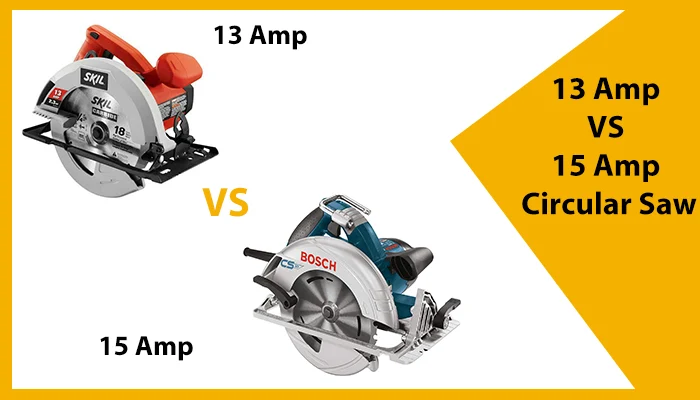Are you wondering what amp circular saw you need for your woodworking projects? Well, you’ve come to the right place! We’re here to help you navigate the world of circular saws and find the perfect fit for your needs. Whether you’re a seasoned DIY enthusiast or just starting out, choosing the right amp rating is crucial for achieving the best results. So let’s dive in and discover the answer to the question, “What amp circular saw do I need?”
When it comes to circular saws, the amp rating determines the power and cutting ability of the tool. Think of it like the horsepower of a car. The higher the amp rating, the more power the saw will have to tackle tough materials and make smoother cuts. So if you’re planning to work with thick hardwoods or frequently take on demanding projects, a higher amp circular saw would be your best bet.
On the other hand, if you’re primarily working with softer woods or only need a circular saw for light-duty tasks around the house, a lower amp rating might be sufficient. It’s all about finding the right balance between power and versatility for your specific needs. So, before making a purchase, consider the types of projects you’ll be undertaking and match the amp rating accordingly. With the right circular saw by your side, you’ll be ready to tackle any woodworking project that comes your way!

What Amp Circular Saw Do I Need?
Welcome to our guide on choosing the right amp circular saw for your needs. Whether you’re a DIY enthusiast or a professional carpenter, finding the perfect amp rating for your circular saw is crucial. In this article, we’ll delve into the factors to consider, the benefits of different amp ratings, and provide tips for choosing the right one. Let’s get started!
Amp Ratings Demystified
Understanding amp ratings is the key to selecting the right circular saw for your projects. Amps, short for amperes, measure the electrical current requirement of the saw. In simple terms, a higher amp rating means more power and torque, allowing the saw to handle tougher materials and make deeper cuts. However, choosing the right amp rating also depends on the nature of your work.
When it comes to the amp rating, circular saws typically range from 10 to 15 amps. Let’s explore different amp ratings and their suitability for various tasks:
1. 10 Amps: Lightweight and Versatile
If you’re a DIYer or someone who tackles light to medium-duty projects, a 10 amp circular saw is a great choice. These saws are lightweight, maneuverable, and perfect for cutting through plywood, softwoods, and even thinner hardwoods. Their lower amp rating also means less strain on your hand and arm, making them ideal for prolonged use.
However, keep in mind that 10 amp saws may struggle with more robust materials like dense hardwoods or thick lumber. If you anticipate working with such materials frequently, a higher amp rating might be more suitable.
Benefits of 10 Amp Circular Saws:
- Lightweight and easy to handle
- Great for light to medium-duty projects
- Less strain on the user
2. 12 Amps: The All-Purpose Workhorse
If you’re a professional or someone who frequently works with a variety of materials, a 12 amp circular saw offers a great balance of power and versatility. These saws can handle most woodworking tasks efficiently, including cutting through hardwoods, plywood, and even thicker lumber.
With a 12 amp rating, you’ll have the power and torque needed for demanding projects without the excessive weight or strain of higher amp-rated saws. They strike a perfect balance for professionals seeking a reliable and adaptable circular saw.
Benefits of 12 Amp Circular Saws:
- Powerful enough for versatile woodworking tasks
- Suitable for cutting hardwoods, plywood, and thicker lumber
- Balanced performance without excessive weight
3. 15 Amps: Maximum Power and Performance
For heavy-duty and professional applications, a 15 amp circular saw is the go-to choice. These saws offer maximum power and performance, effortlessly cutting through any material, including dense hardwoods and thick lumber. Their high amp rating guarantees maximum torque and exceptional cutting speed.
While the power of a 15 amp saw is undeniable, keep in mind that they tend to be bulkier and heavier than their lower amp counterparts. They’re generally more suitable for professional carpenters and contractors who require the extra power for frequent heavy-duty use.
Benefits of 15 Amp Circular Saws:
- Unmatched power and torque
- Efficient cutting through any material
- Perfect for heavy-duty and professional use
Tips for Choosing the Right Amp Circular Saw
Now that you have a clear understanding of the different amp ratings available, here are some additional tips to help you choose the right circular saw for your needs:
1. Consider Your Projects
Think about the type of projects you handle regularly. Are they light-duty or heavy-duty? Knowing the demands of your work will guide you in selecting the appropriate amp rating.
2. Evaluate Comfort and Portability
If you anticipate using the circular saw for extended periods, consider the weight and ergonomic features. A lighter saw with comfortable grips will minimize hand and arm fatigue.
3. Safety First
Ensure the circular saw you choose has essential safety features like blade guards, electric brake systems, and a reliable switch mechanism.
4. Read Reviews and Get Recommendations
Research different circular saw brands and models, read user reviews, and seek recommendations from professionals or seasoned DIYers. Their insights can be invaluable in making an informed decision.
5. Budget Considerations
While heavy-duty saws with higher amp ratings tend to be pricier, don’t overlook other factors like warranties, durability, and overall quality. It’s important to strike a balance between your budget and the features that matter most to you.
By considering these tips and understanding the different amp ratings, you’ll be well-equipped to select the perfect circular saw for your needs. Whether it’s a 10, 12, or 15 amp saw, remember to prioritize safety and ensure proper maintenance to extend the life of your tool. Happy cutting!
Common Circular Saw FAQs
Important Safety Tips
Circular Saw Maintenance Guide
Key Takeaways: What Amp Circular Saw Do I Need?
- Higher amp circular saws provide more power for cutting through tougher materials.
- For general DIY projects, a 15-amp circular saw should be sufficient.
- If you work with dense or thick materials regularly, consider a 20-amp or higher circular saw.
- Amp rating determines the cutting speed and performance of the circular saw.
- Always consider the type and thickness of materials you will be cutting before choosing the amp rating.
Frequently Asked Questions
Are you unsure about which amp circular saw you need for your projects? Check out these commonly asked questions to help you find the right one:
1. What is the importance of choosing the correct amp rating for a circular saw?
Choosing the right amp rating for your circular saw is crucial because it determines the power and performance of the tool. The amp rating indicates the electrical current the saw draws from the power source. Higher amp ratings typically result in a more powerful saw that can tackle heavier-duty tasks. However, it’s essential to consider the specific needs of your projects to avoid investing in unnecessary power. For simple DIY projects, a lower amp rating may be sufficient, while professional contractors may require a higher amp rating to handle demanding tasks.
By understanding your needs and the amp ratings, you can make a well-informed decision and ensure optimal performance from your circular saw.
2. What factors should I consider when determining the appropriate amp rating for a circular saw?
Several factors come into play when deciding on the right amp rating for your circular saw:
Type of Projects: Consider the type of projects you will primarily be working on. If you plan on tackling heavy-duty tasks, such as cutting thick hardwood or continuous use on construction sites, a higher amp rating would be suitable. For lighter DIY projects or occasional use, a lower amp rating may suffice.
Power Outlet Capacity: Check the electrical capacity of the outlets you will be using. If they can safely handle higher amp loads, you have more flexibility in choosing a circular saw with a higher amp rating. However, if your outlets have lower capacity, it’s important not to exceed their limits to prevent tripping breakers or electrical hazards.
Budget: Consider your budget when choosing a circular saw. Higher amp-rated saws tend to come with a higher price tag. It’s important to strike a balance between your needs and your budget to ensure the best value for your money.
3. Can I use a circular saw with a lower amp rating than recommended for a particular task?
While it may be tempting to use a circular saw with a lower amp rating than recommended for a task, it is not advisable. The amp rating of a saw is determined based on its motor power and capability to handle specific tasks. Using a circular saw with a lower amp rating may not provide enough power to cut through tougher materials or may strain the motor, leading to premature wear and tear.
To ensure optimal performance and longevity of your circular saw, it’s best to adhere to the recommended amp rating for each task.
4. Is there a significant difference in performance between circular saws with different amp ratings?
Yes, there can be a significant difference in performance between circular saws with different amp ratings. Higher amp-rated saws generally have more cutting power, allowing them to handle thicker and denser materials effortlessly. They also tend to have more advanced features, such as electronic speed control, which can enhance precision and control.
However, it’s important to note that the performance requirements of each individual may vary. If you primarily work on lighter projects or have budget constraints, a circular saw with a lower amp rating can still provide satisfactory performance for your needs.
5. Are there any safety considerations when using a circular saw with different amp ratings?
Using a circular saw, regardless of its amp rating, requires certain safety precautions. Ensure you follow these guidelines:
Eye and Ear Protection: Always wear safety glasses or goggles to protect your eyes from flying debris. Additionally, use ear protection to prevent hearing damage from the saw’s noise.
Secure Workpiece: Securely clamp or hold the workpiece to prevent any movement or slipping during the cutting process. This ensures stability and reduces the risk of accidents.
Proper Blade Guard Usage: Ensure the blade guard is functioning correctly and properly covers the blade during operation. The guard helps prevent accidental contact with the blade, reducing the risk of injury.
Safe Handling and Storage: When not in use, store the circular saw in a safe place, away from children or anyone unfamiliar with its operation. Always disconnect the saw from the power source before cleaning, replacing blades, or making any adjustments.
Following these safety measures will help you use any circular saw, regardless of its amp rating, in a secure and responsible manner.

Summary
So, here’s the lowdown on choosing the right circular saw for your needs. First, consider the type of work you’ll be doing – a cordless saw is great for portability, while a corded one offers consistent power. Next, think about the size – a 6 ½ inch saw is great for most DIY projects, but if you’re tackling larger tasks, go for a 7 ¼ inch. And finally, blade type – opt for a carbide-tipped blade for versatility and durability. Remember, safety first, so always wear protective gear and follow the instructions. Happy sawing!
In a nutshell, choosing the right circular saw is all about considering your specific requirements. Think about your work type, pick the right size, and opt for a reliable blade. Keep safety in mind and have fun using your new tool!
